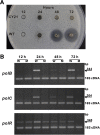Genetic dissection of the polyoxin building block-carbamoylpolyoxamic acid biosynthesis revealing the "pathway redundancy" in metabolic networks
- PMID: 24314013
- PMCID: PMC4029187
- DOI: 10.1186/1475-2859-12-121
Genetic dissection of the polyoxin building block-carbamoylpolyoxamic acid biosynthesis revealing the "pathway redundancy" in metabolic networks
Abstract
Background: Polyoxin, a peptidyl nucleoside antibiotic, consists of three building blocks including a nucleoside skeleton, polyoximic acid (POIA), and carbamoylpolyoxamic acid (CPOAA), however, little is known about the "pathway redundancy" of the metabolic networks directing the CPOAA biosynthesis in the cell factories of the polyoxin producer.
Results: Here we report the genetic characterization of CPOAA biosynthesis with revealing a "pathway redundancy" in metabolic networks. Independent mutation of the four genes (polL-N and polP) directly resulted in the accumulation of polyoxin I, suggesting their positive roles for CPOAA biosynthesis. Moreover, the individual mutant of polN and polP also partially retains polyoxin production, suggesting the existence of the alternative homologs substituting their functional roles.
Conclusions: It is unveiled that argA and argB in L-arginine biosynthetic pathway contributed to the "pathway redundancy", more interestingly, argB in S. cacaoi is indispensible for both polyoxin production and L-arginine biosynthesis. These data should provide an example for the research on the "pathway redundancy" in metabolic networks, and lay a solid foundation for targeted enhancement of polyoxin production with synthetic biology strategies.
Figures







Similar articles
-
Deciphering Carbamoylpolyoxamic Acid Biosynthesis Reveals Unusual Acetylation Cycle Associated with Tandem Reduction and Sequential Hydroxylation.Cell Chem Biol. 2016 Aug 18;23(8):935-44. doi: 10.1016/j.chembiol.2016.07.011. Cell Chem Biol. 2016. PMID: 27541195
-
An ATP-Dependent Ligase with Substrate Flexibility Involved in Assembly of the Peptidyl Nucleoside Antibiotic Polyoxin.Appl Environ Microbiol. 2018 Jun 18;84(13):e00501-18. doi: 10.1128/AEM.00501-18. Print 2018 Jul 1. Appl Environ Microbiol. 2018. PMID: 29703734 Free PMC article.
-
Reconstruction of a hybrid nucleoside antibiotic gene cluster based on scarless modification of large DNA fragments.Sci China Life Sci. 2017 Sep;60(9):968-979. doi: 10.1007/s11427-017-9119-1. Epub 2017 Aug 21. Sci China Life Sci. 2017. PMID: 28840532
-
Trends in lignin modification: a comprehensive analysis of the effects of genetic manipulations/mutations on lignification and vascular integrity.Phytochemistry. 2002 Oct;61(3):221-94. doi: 10.1016/s0031-9422(02)00211-x. Phytochemistry. 2002. PMID: 12359514 Review.
-
Computational tools for guided discovery and engineering of metabolic pathways.Methods Mol Biol. 2013;985:123-47. doi: 10.1007/978-1-62703-299-5_8. Methods Mol Biol. 2013. PMID: 23417803 Review.
Cited by
-
A genetically amenable platensimycin- and platencin-overproducer as a platform for biosynthetic explorations: a showcase of PtmO4, a long-chain acyl-CoA dehydrogenase.Mol Biosyst. 2015 Oct;11(10):2717-26. doi: 10.1039/c5mb00303b. Mol Biosyst. 2015. PMID: 26055255 Free PMC article.
-
Natural and engineered biosynthesis of nucleoside antibiotics in Actinomycetes.J Ind Microbiol Biotechnol. 2016 Mar;43(2-3):401-17. doi: 10.1007/s10295-015-1636-3. Epub 2015 Jul 8. J Ind Microbiol Biotechnol. 2016. PMID: 26153500 Review.
-
Identification and characterization of enzymes involved in the biosynthesis of pyrimidine nucleoside antibiotics.Nat Prod Rep. 2021 Jul 21;38(7):1362-1407. doi: 10.1039/d0np00064g. Nat Prod Rep. 2021. PMID: 33404015 Free PMC article. Review.
References
-
- Suzuki S, Isono K, Nagatsu J, Mizutani T, Kawashima Y, Mizuno T. A new antibiotic, polyoxin A. J Antibiot (Tokyo) 1965;12:131. - PubMed
-
- Isono KN, Kobinata J, Sasaki K, Suzuki S. Studies on polyoxins antifungal antibiotics part V: isolation and characterization of polyoixns C, D, E, F, G. Hand I Agri Biol Chem. 1967;12:190–199. doi: 10.1271/bbb1961.31.190. - DOI
-
- Isono KN, Kawashima J, Suzuki YS. Studies on polyoxins, antifungal antibiotics part I: isolation and characterization of polyoxins A and B. Agr Biol Chem. 1965;12:854.
Publication types
MeSH terms
Substances
Associated data
- Actions
LinkOut - more resources
Full Text Sources
Other Literature Sources

